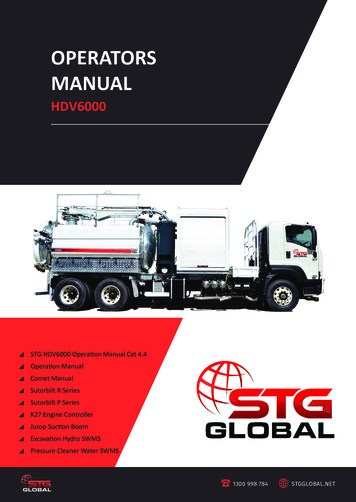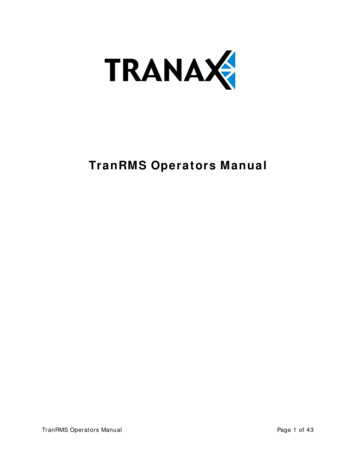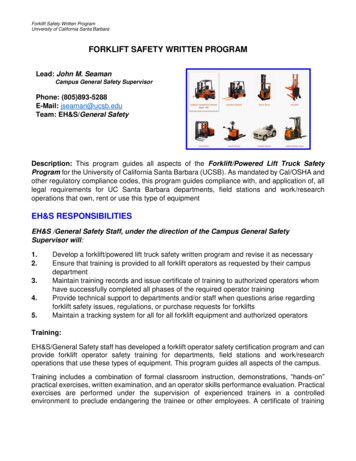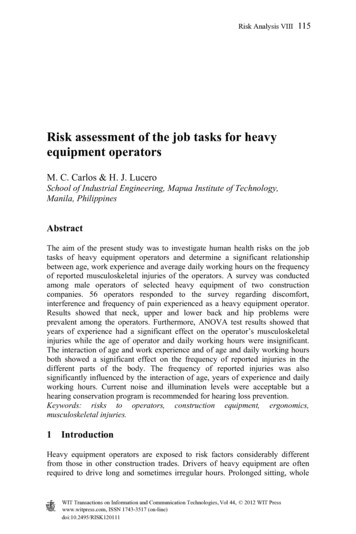
Transcription
OPERATORSMANUALHDV6000STG HDV6000 Opera on Manual Cat 4.4Opera on ManualComet ManualSutorbilt R SeriesSutorbilt P SeriesK27 Engine ControllerJurop Suc on BoomExcava on Hydro SWMSPressure Cleaner Water SWMS1300 998 784STGGLOBAL.NET
OPERATORSMANUALHDV6000Sec on 11300 998 784STGGLOBAL.NET
Index1. General Safety Precautions Safety precautions for entering tanks Safety precautions for handling material Safety precautions for operating equipment2. General Safety Rules3. High Pressure Water safety Medical Alert General General Safety Procedures4. Component Identification5. Vacuum/Blower/Tank Operation Starting Procedure Starting – Machine Operation Starting the Engine Shutdown Procedures Shutdown the Machine6. Using the Pressure Washer7. Engaging the Vacuum8. Engaging the Pressure Blower9. Safe Work Procedures10. Atmospheric Testing11. Bonding and Grounding12. Training13. Hydraulic Operation14. Maintenance15. Hydraulic System16. Vacuum Final Filter17. Primary Shutoff18. Vacuum Module Mounting19. Captured Mounting Bracket Springs20. 6000lt Electric Control Box Circuit Diagram 121. 6000lt Electric Control Box Circuit Diagram 222. 6000lt Vacuum Unit Bottom Rail Assemble0
Congratulations on your purchase of an STG Global product. Your Vacuum Tankerwill give you years of dependable service if the proper operating and maintenanceinstructions are observed. We recommend that you read this manual carefully tobecome thoroughly familiar with your tanker equipment prior to operation.1. GENERAL SAFETY PRECAUTIONSa.Safety Precautions for Entering TanksFollow these safety precautions, and insist that those working with you follow them.Most industrial equipment accidents can be avoided by observing safety precautions.b.Safety Precautions for Handling MaterialDANGER: DO NOT stand near the oil catch muffler or discharge valve when loadingor unloading the tank. Sewer gases vented out of the oil catch muffler will settledownward. Sewer gases can also be expelled out of the discharge valve whenreleasing tank pressure. Inhaling sewer gases can cause severe injury or death.WARNING: DO NOT allow children or irresponsible people near your work area orequipment. Fatalities have occurred when children have fallen or climbed intounattended septic/holding tanks. Secure your work area from entry of unauthorizedpersons in the vicinity.WARNING: Secure all access covers against unauthorized entry after pumping aseptic/holding tank. Fatalities have occurred where children have fallen intoseptic/holding tank openings that had not been properly secured. Securely chain andpadlock above ground access openings. Bury underground access openings by atleast six inches of dirt.WARNING: Always wear protective gloves, eye protection and, appropriate clothingwhen working with sewage affluent or septage. These materials may containhazardous chemicals, disposed of through the drain, which can cause severe injuryor even death due to contact. These affluent also contain bacteria, which can be asource of infection, especially if exposed to open cuts or sores.DANGER: DO NOT enter a transport, septic, or holding tank without cleaning andproviding adequate ventilation to the interior of the tank. Sewer gas is deadly ifinhaled; in addition, it depletes the oxygen in a confined space, which can causeasphyxiation.1
DANGER: DO NOT enter a transport, septic, or holding tank without using arespirator that supplies grade D breathing air or a self-contained breathing apparatus.In addition, DO NOT use this equipment without training and familiarity with it.Entering a tank exposed to sewage affluent without a correct breathing apparatus, orwith improper use of it, can cause death.DANGER: DO NOT enter a transport, septic, or holding tank without protectiveclothing. Sewer gas can be absorbed through the skin causing serious injury ordeath.WARNING: When entering a transport, septic, or holding tank, always have someonestanding by to provide assistance, and always have a respirator that supplies grade Dbreathing air or a self-contained breathing apparatus on hand for them. In the eventof an attempted rescue, this equipment is necessary to prevent death of the rescuer.WARNING: Attach a safety-harness and rope to any person that enters a transport,septic, or holding tank. Have the safety-harness rope held by a person standing by toprovide assistance outside the tank. An attempted rescue without the advantage of arope and harness can be life threatening to the rescuer.WARNING: Entry into a transport, septic, or holding tank is confined space entry.Persons entering these tanks for any purpose must be trained in and follow OSHAconfined space safety procedures.c.Safety Precautions for Operating EquipmentDANGER: Stop the truck motor, remove all persons from the truck cab, and chockthe truck tires before servicing any component under the truck; this includeslubricating the vacuum pump or the PTO driveline. Contact with a rotatingmechanism can cause entanglement that can lead to death. A truck that begins to rollis a crushing hazard that can lead to death.WARNING: Keep hands, feet, hair, and clothing away from moving parts. Contactwith a moving mechanism can cause entanglement that can lead dismemberment ordeath.WARNING: Escaping hydraulic oil under pressure can have sufficient force topenetrate your skin, which can cause serious injury. Before operating hydrauliccomponents, be sure all connections are tight and hoses are not damaged. Relieveall pressure before disconnecting hydraulic lines or repairing leaks.CAUTION: When off-loading under pressure, maintain control of the end of the hose.2
Pressurised discharge can cause a hose end to whip about and create the potentialfor spraying persons in the areaWARNING: Keep all shields in place. Shields and covers are designed to protect theoperator from entanglement in moving parts, which can lead to serious injury ordeath. DO NOT remove shields from the unit except when servicing; then, replaceimmediately.WARNING: The truck’s cornering and braking abilities are reduced when the tank isloaded. Drive at a reasonable speed with a loaded tank; reduce speed on rough orhilly terrain, before making an anticipated stop, and when cornering.WARNING: Make certain everyone is clear of the tanker truck and the immediatearea before starting the engine, engaging power, and operating the equipment. Theinherent hazards of septic pumping can cause serious injury or death to untrainedpersons that enter this area.WARNING: DO NOT allow anyone to ride on the outside of the tanker truck when it isin motion. Failure to follow this precaution could result in persons falling off the truckand possibly getting run over, which could cause serious injury or death.WARNING: Before backing-up the truck, inspect the area to be backed into, andclear all hazards, pets, and people from it. Make sure that backup lights and theback-up alarm are maintained and in good working condition. Because of the truckmounted tank, the driver will experience a large blind spot behind the truck. Fatalitieshave occurred when persons were run over by a tanker truck.CAUTION: Avoid contact with the vacuum pump during or immediately afteroperation. Operating temperatures can range from near 200oF to over 00oF,depending on the make and model of pump and on the working conditions. Contactwith a hot vacuum pump can cause severe burns.2. GENERAL SAFETY RULESWARNING: Water at high pressure can be dangerous and can cause damage ifthe operator is careless. Never allow anyone to operate this pressure washerunless they are familiar with the safety precautions.1. NEVER direct the spray towards any person or animal.2. NEVER hold your finger over the high-pressure nozzle.3. NEVER allow children or untrained personnel to use this machine.3
NEVER operate the machine with any of the covers removed.NEVER attempt any repairs to this machine. Always refer to your dealer.NEVER supply any liquid other than water to the water inlet.NEVER use the detergent pickup facility to introduce flammable liquids/solvents,e.g. paint thinners, petrol, oil as there is a risk of explosion.8. ALWAYS release any residual pressure in the system by turning off the watersupply and operating the trigger before disconnecting any hose or accessory.9. ALWAYS keep the machine itself dry and well clear of water spray.10. ALWAYS wear protective clothing and safety glasses. Loose particles and otherdebris may be propelled at high speed by the water jet.11. ALWAYS grip the gun firmly and expect the spray gun to ‘kick’ when starting.12. ALWAYS respect the requirements of the local water company. Pressure washersmay only be connected to the mains drinking water supply if a system separator(also known as a backflow preventer) is installed in the supply hose.13. ALWAYS disconnect from the water supply, and ensure the system is completelydrained when not in use. Store in a cool dry location.14. ONLY use chemical cleaning agents (detergents), that are approved for pressurewashers.15. WARNING High pressure water jets can be dangerous if subject to misuse. Thejet must not be directed at a person or anything that they are wearing.16. NEVER direct the jet at electrical equipment or the machine itself.17. WARNING High pressure hoses, fittings and couplings are important for thesafety of the machine. Use only hoses, fittings and couplings recommended bythe manufacturer.18. WARNING Water that has flowed through a system separator (also known as abackflow preventer) is considered non-drinkable19. NEVER use the pressure washer if the inlet/outlet hoses or important parts of themachine are damaged.4.5.6.7.4
3. HIGH PRESSURE WATER SAFETYWARNINGAn injury caused by high pressure water jets can be serious. In the event of anywater jet injury: Seek medical attention immediately. Do not delay! Inform the doctor of the cause of the injury. Tell the physician what type of waterjet project was being performed at the timeof the accident and the source of the water.A.Medical AlertThis patient may be suffering from a water jet injury. Evaluation and managementshould parallel that of a gunshot injury. The external manifestations of the injurycannot be used to predict the extent of internal damage. Initial management shouldinclude stabilisation and a thorough neurovascular examination. X-rays can be usedto assess subcutaneous air and foreign bodies distant from the site of injury.Injuries to the extremities can involve extensive nerve, muscle, vessel damage, aswell as cause a distal compartment syndrome. Injuries to the torso can involveinternal organ damage. Surgical consultation should be obtained. Aggressiveirrigation and debridement is recommended. Surgical decompression and explorationmay also be necessary.Angiographic studies are recommended pre-operatively if arterial injury is suspected.Bandages with a hygroscopic solution (MgSO4) and hyperbaric oxygen treatmenthave been used as adjunctive therapy to decrease pain, edema and subcutaneousemphysema. Unusual infections with uncommon organisms in immunocompetentpatients have been seen; the source of the water is important in deciding on initial,empiric antibiotic treatment, and broad-spectrum intravenous antibiotic treatment,and broad-spectrum intravenous antibiotics should be administered. Cultures shouldbe obtained.5
Operators using or working around high pressure water systems need to takeadditional precautions including specialised personal protection equipmentB.GeneralWARNINGSTG Global could not possibly, know, evaluate, and advise the service trade of allconceivable ways in which operation or service might be done or the possiblehazardous consequences of each way. Anyone who uses operational procedures,service procedures, or tools, whether recommended by STG Global or not, must firstsatisfy himself thoroughly that neither his safety nor the product safety will bejeopardised by the methods he shall select.STG Global vacuum systems are designed to user specifications. Theowner/operator/user is responsible for the safe use and application of this equipmentand proper waste disposal. Transportation and disposal of waste may be subject tolocal, state or federal laws.Read and follow the safety practices described in this manual and in the commonindustry references that are also provided to help in the decision-making process.C.General Safety Procedures Perform all operations with at least two operators.Only trained personnel should operate, perform maintenance, or repair the unit.Work area must be clear and clean for good visibility and footing.All operators must wear safety apparel: hard hat, visor and / or goggles, earprotection, rain suit, safety- toe shoes or boots with non-skid soles and water proofgloves are recommended.Never alter system components or reprogram. System components must be usedonly as intended.If a malfunction occurs, immediately stop and follow repair instructions.The unit must be thoroughly cleaned between jobs to prevent cross contamination orchemical reactions.6
Never use this unit in any type of rescue operation where the vacuum is used for therescue.Operating the unit inside a building or confined areas can create additional risks tothe unit, operators and building occupants. Engine exhaust gas can reach deadlylevels. Heat buildup from the engine and blower discharge can overheat people andequipment.Never use an air mover machine for vacuuming hydrocarbon or flammable materialsunless the flash point of the material is 60 (C) or higher. Pressurised or pumpoff-loading is not permitted unless the flash point of the material is 50 (C) or higherunless nitrogen is present.Never operate engines where there are or can be combustible vapors. Vapors pulledin to an engine air intake can cause engine acceleration and over-speeding. This canresult in death, injury and property damage.Reference to OSHA regulations are for informational purposes only and not intendedas legal advice.The use of this equipment in the removal or handling of any regulated substance ormaterial must be performed in strict accordance with all applicable federal, state andlocal laws and regulations, and approved safety and personal protection equipmentand clothing must be used and worn at all times.Never use an air mover machine to vacuum dusty materials until the Safety DataSheet(s) (SDS) have been consulted to determine if the dust(s) have an explosivepotential (Combustible Dusts). Only air mover units that are part of a verified assuredgrounding system that have bags, doors and any other non-welded debris bodycomponents grounded to the debris body can be used if the materials containcombustible dusts.7
4. COMPONENT IDENTIFICATIONEngine Control PanelControl Panel8
HourmeterTachometerIgnition SwitchIndicator lightsHydraulic EnablePush Top -EnablePush Bottom-DISABLEFlashing BeaconWork Light9
ThrottleTurn CW or Push in -DECREASE RPMTurn CCW or Pull Out In -INCREASERPMHydraulic ControlsEmergency stopCollection TankRaised/lowerRear Door Open/ClosePush open -Raise doorPush Close -Lower doorPush up -RAISE TANKPush-Down-LOWERTANK10
Water SystemWater pump SwitchWater Pump11
Water StrainerHose Reel12
Water Tank Drain Valve LeverVacuum System13
Blower Vacuum14
Blower Pressure/Vacuum Gauge(Pressure / Vacuum (4way) valvelever (option)UP (45 ) - PressureMiddle (Horizontal) - NeutralDown (45 ) - VacuumPress Button - UNLOCKS LEVERRelease Button - LOCKS LEVER15
Primary Shutoff Assembly (Collection Tank Interior)Bag House Lid16
Bag House Drain ValveToolsWater Gun17
5. VACUUM/BLOWER/TANK OPERATIONPlease refer to the truck manufactures operators manualStarting ProcedureStarting - Machine preparationA. Check Caterpillar engine and machine fluid levels. Perform daily or asrecommended in the manufactures operators manualB. Configure machine as follows:Water Pump SwitchSuction Valve4” Dump ValveBag House Drain ValvePressure /Vacuum Selector LeverSWITCH OFFCLOSEDCLOSEDOPENNEUTRALStarting the EngineA. Refer to Lofa panel instructionsShutdown ProceduresShutdown the Machine1. Before shutting down the engine make sure the pressure/vacuum lever is in theneutral position2. Make sure you allow the engine to cool down for 5-10minutes before shutting theengine down (please refer to the Caterpillar engine guidelines)6. USING THE PRESSURE WASHER1. When engaging the pressure washer make sure the Caterpillar engine is at idle2. To engage the pressure washer, push the pressure washer switch to the onposition on the control panel, also for the pressure washer to work the pressureswitch at the rear of the truck must be switched on.3. Once the pressure washer is engaged ramp up the engine rpm to the desiredpressure.18
4. To disengage, idle the engine rpm back and push the pressure washer switch tothe off position7. ENGAGING THE VACUUMRead the Gardner Denver operators manual before use.A. Always have the Caterpillar engine at idle before engaging the vacuum lever (4way valve)B. Engage the vacuum by pushing the 4way valve lever up to the vacuum position.C. Then increase the Caterpillar engine rpm to the desired Vacuum pressure, refer tothe vacuum/pressure gauge for accurate measurementD. To disengage the vacuum, idle the Caterpillar engine down and then disengagethe vacuum lever to the neutral position.8. ENGAGING THE PRESSURE BLOWERA. Always have the Caterpillar engine at idle before engaging the pressure lever (4way valve)B. Engage the pressure by pulling the 4way valve lever down to the pressureposition.C. Then increase the Caterpillar engine rpm to the desired pressure, refer to thevacuum/pressure gauge for accurate measurementD. To disengage the pressure, idle the Caterpillar engine down and then disengagethe pressure lever to the neutral position.During vacuum truck operations, workers are at risk of being exposed to toxic gases,flammable materials and other various hazards. This procedure will address properand safe vacuum truck operations.When work is performed on a non-owned or operated site, the operator’s programshall take precedence, however, this document covers Your Company employeesand contractors and shall be used on owned premises, or when an operator’sprogram doesn’t exist or is less stringent. Employees will be aware of provisions ofsite specific contingency/emergency plans by either Your Company or of a facilityowner.19
9. SAFE WORK PROCEDURESSafe work procedures for vacuum truck operations must address the potential forchemical reactions and the potential release of toxic gas or fumes. The variety offluids or substances that vacuum trucks typically carry must also be taken intoconsideration. Before starting any vacuum truck operations, Your Company shallmake sure that vacuum truck owners and operators, as well as facility personnel areaware of the following:A. The numerous potential hazards associated with vacuum truck operations inpetroleum facilities including, but not limited to: Sources of ignition, flammable atmospheres, potential hazards associatedwith the surrounding area, toxic vapors and their PELs and STELs. Additional hazards such as slips and falls, spills and releases, fires andexplosions and accidents within the facility or on the highway.B. The evacuation and rescue procedures in the event of a toxic gas leak.C. Ensure that air quality monitoring at the work site is continuous at such locationsas the discharge area of the vacuum truck venting hose.D. Ensure that first aid is readily available on site in the event of exposure to toxicgas.E. Consult the manufacturer’s instructions to confirm that the vacuum equipment isdesigned for the particular transfer operation.F. Ensure that all equipment – including tank and vacuum trucks, and pumpingequipment – is in safe working condition. Ensure that the tank interior, filterbaghouse, and cyclone separators are clean and free of any substances that mayreact with the liquids to be vacuumed or transferred.G. Before beginning operations, vacuum truck operators shall obtain any requiredpermits and inspect vacuum trucks, equipment, and loading/off-loading sites toassure safe operations.20
Under normal conditions, the absence of oxygen minimises the risk of ignition in avacuum truck. However, operating rotary lobe blowers and vacuum pumps at highspeeds creates high air movement and high vacuum levels, resulting in highdischarge air temperatures and high discharge vapor concentrations that can presentpotentially ignitable conditions.10. ATMOSPHERIC TESTINGThe areas where vacuum trucks will operate must be free of hydrocarbon vapors inthe flammable range.*The areas where the vacuum truck operator and others work without respiratorsmust also be at or below air contaminants PELs/STELs. If there is any questionwhether the area is vapor or toxic gas free, atmospheric testing shall be performed bya qualified person using properly calibrated and adjusted detectors.Testing shall be conducted prior to starting any operations, and if necessaryduring operations, including, but not limited to the following: When operations in the area are subject to change, such as automatic pumpstart-up or product receipt into, or transfer out of a tank located near thetransfer operations. When off-loading When atmospheric conditions change, such as wind direction When an emergency, such as product release, occurs within the facility thatmay affect atmospheric conditions in the transfer areaTo prevent exposure to toxic gases during transfer operations: Never transfer fluids from one truck to another unless it has been establishedthat no chemical reaction will occur Position trucks to minimise exposure to any discharged gases and fumes. Ensure that discharge lines are long enough and large enough for safeoperation. Position vent lines away from workers and workstations, including controlpanels, valve handles, gauges, shut-offs, and hose attachment points – if21
possible, use a vertical exhaust stack to divert exhaust gases away fromworkers and ignition sources. Check air monitoring equipment during operations to confirm that venting isproceeding safely. Monitor the following: Tank level indicators to avoid overfilling. Tank pressure gauges to avoid over-pressurising receiving tanks or creatingexcessive vacuum in supply tanks. Minimise the air introduced into the system when pressure loading orunloading – submerge the suction line in liquid, or reduce the vacuum pumpspeed when skimming or nearing the end of a load. Maintain a log of transported fluids and any potential residue. Use gravityloading and unloading whenever possible. Use a vapor recovery system, when available, to avoid venting tanks directly tothe atmosphere. Vacuum hoses constructed of conductive materials or thick walled hose withimbedded conductive wiring shall be used when transferring flammable andcombustible liquids when the potential for a flammable atmosphere exists forthe area of operations. Conductive hoses shall provide suitable electrical conductance less than orequal to 1 mega ohm per 100 feet (as determined by the hose manufacturer).Thin walled metallic spiral-wound conductive hoses should not be usedbecause of the potential for electrical discharge through the thin plastic thatcovers the metal spiral.11. BONDING AND GROUNDINGThe complete vacuum transfer system needs to be bonded so that there is acontinuous conductive path from the vacuum truck through the hose and nozzle tothe tank or source container and grounded to dissipate stray currents to earth(ground).Prior to starting transfer operations, vacuum trucks need to be grounded directly tothe earth or bonded to another object that is inherently grounded (due to proper22
contact with the earth) such as a large storage tank or underground piping. A safeand proper ground to earth may be achieved by connecting to any properly groundedobject including, but not limited to, any one or more of the following examples: A metal frame of a building, tank, or equipment that is grounded. An existing facility grounding system such as that installed at a loading rack. Fire hydrants, metal light posts, or underground metal piping with at least 10’ ofcontact with earth.12. TRAININGVenting:Several methods can be used by vacuum truck operators to safely vent vacuumpump exhaust vapors, including, but not limited, to the following: Operators can prevent dieseling by locating the vacuum truck upwind of vaporsources and by extending the vacuum pump discharge away from the dieselengine air intake. Vapors may be returned to the source container using conductive and closedconnections. Vapors may be vented into the atmosphere to a safe location using a safetyventuri. Vacuum truck operators may provide vertical exhaust stacks extendingapproximately 3m above the vacuum truck (or higher if necessary) to dissipatethe vapors before they reach ignition sources or other potential hazards andpersonnel. Vacuum truck operators may attach a length of exhaust hose to the vacuumexhaust that is long enough to reach an area that is free from potentialhazards, sources of ignition, and personnel – the hose should preferably beextended 25m downwind of the truck and away from the source of the liquids.Vacuum truck operators shall be trained and properly licensed in accordance withapplicable regulations. Vacuum truck personnel working in petroleum facilities shallbe trained in:23
The safe operation of the vacuum equipment and be familiar with hazards ofthe petroleum products, byproducts, wastes and materials being transferred. Aware of relevant government and facility safety procedures and emergencyresponse requirements. MSDS of the substances being vacuumed or transferred. Appropriate PPE. The requirement that all personnel shall leave the vacuum truck cab duringloading and off-loading operations. The requirement that when transferring flammable liquids or hazardousmaterials, vacuum truck operators shall remain positioned between thevacuum truck and the source or receiving tank, vessel, or container and within10m of the vacuum truck throughout the duration. The requirement that vacuum truck operators shall monitor the transferoperation and be ready to quickly close the product valve and stop the pump inthe event of a blocked line or release of material through a broken hose orconnection. The knowledge that smoking, or any other source of ignition, shall not bepermitted within at least 100’ (depending on local procedures and atmosphericconditions) of the truck, the discharge of the vacuum pump, or any other vaporsource. The requirement that vacuum trucks shall not enter a tank dike area until suchareas have been checked/monitored and rendered safe. Vacuum truck cargo tanks shall be depressurised. The effect of speeds, turns, and the changing center of gravity. Maintaining proper distances when operating vacuum trucks inside facilitieswith restricted clearances.24
13. HYDRAULIC OPERATION1. Before running the hydraulics make sure the hydraulic oil is showing inthe hydraulic sight glass at the correct level2. For hydraulic operation, the caterpillar engine must be running,3. Once the engine is running engage the hydraulics by switching thehydraulic switch to the on position on the control panel.4. The hydraulics can be operated 4 ways, by manual override on thehydraulic valve bank, via the pendant with lead, by wireless remote or bythe electrical buttons on the electrical board.25
Emergency stopCollection Tank Raised(H2)Rear Door Open/Close/lowerPush open -Raise doorPush up -RAISE TANKPush Close -Lower doorPush-Down-LOWERTANK26
The red emergency stop button must be out for the pendant to work.Also, the work button must be pressed initially for the pendant to work & the on buttonmust be pressed.27
14. MAINTENANCECaterpillar Engine- refer to the manufactures operator and maintenance manualGarner Denver 5LR blower/vacuum- refer to the manufactures operator andmaintenance manual.Comet rw6040 pressure washer - refer to the manufactures operator andmaintenance manual.15. HYDRAULIC SYSTEMCheck the oil in the hydraulic reservoir daily. Keep the reservoir filled with hyd68 orequivalent hydraulic oil.If the oil level drops, fill the reservoir, and then inspect the complete hydraulic systemfor leakage. Before making any repairs, be sure to have a qualified person relieve allpressure in the system.WARNING: Escaping hydraulic oil under pressure can have sufficient force topenetrate your skin, which can cause serious injury. Before operatinghydraulic components, be sure all connections are tight and hoses are notdamaged. Relieve all pressure before disconnecting hydraulic lines orrepairing leaks.Hydraulic Oil & System- maintenance should be conducted by a qualified person, thehydraulic oil should be changed at a maximum of every 1000hrs, the hydraulic oilfilter should be changed every 500hrs maximum or 6months or which every comessooner.16. VACUUM FINAL FILTERClean the filter as often as every day, depending upon the content of the materialbeing pumped. For example, when cleaning the filter, provide yourself with gloves,eye protection, and protective clothing and then use the following procedure:A. Loosen the wing nuts and remove the cover.B. Remove the filter canisters.C. Clean the lint from the filter canisters. If necessary, swirl the filter in a drum ofsoapy water to loosen the material.28
D. Reassemble in the reverse order.WARNING: Wear protective gloves, eye protection and appropriate clothingwhen cleaning the filter. Being a component of the vacuum system, the filter issubject to exposure by sewage or septage. These materials may containhazardous chemicals and bacteria, which can cause infection, injury, or evendeath due to contact.17. PRIMARY SHUTOFFInspect the primary shutoff every 2 weeks to check the rubber ball seat and thetightness of all fasteners.Your va
Vacuum/Blower/Tank Operation Starting Procedure Starting - Machine Operation Starting the Engine Shutdown Procedures Shutdown the Machine 6. Using the Pressure Washer 7. Engaging the Vacuum 8. Engaging the Pressure Blower 9. Safe Work Procedures 10. Atmospheric Testing 11. Bonding and Grounding 12. Training 13. Hydraulic Operation 14. Maintenance 15. Hydraulic System 16 .











